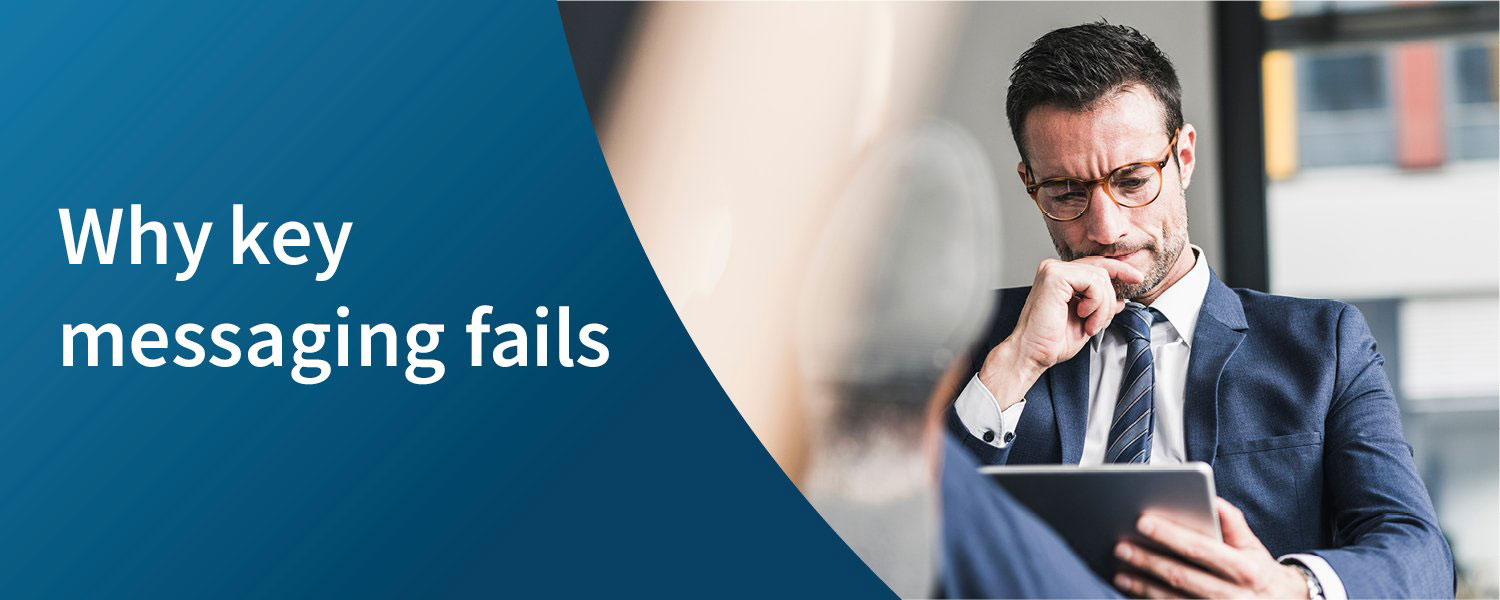Why key messaging fails

Every sales and marketing executive knows that, whether you are crafting social media marketing content or in a room with a prospective client, you are telling a story. The problem is that, too often, marketing and sales teams end up telling the wrong story in the wrong way, focusing on what they want to say about a product or a service instead of understanding the customer’s pain points. This usually results in them telling their own story about the solution on offer, which overlooks the challenges customers specifically want to overcome. By failing to identify and appeal to these challenges, your business could miss key opportunities to highlight the true value your solutions offer to customers, and to help them understand how your services will help them.
The shift from pain to gain with brand messaging

Every organisation has a solution, whether it’s a product, service, or mix of both, that alleviates a need or pain point for their customer.
While most businesses understand the fundamental problem they are solving, and who they are solving it for, this information is not always clearly articulated in a way that shows customers that their challenges are understood and that there is alignment between an organisation’s solutions and their customers’ problems.
Unfortunately, when the message is solution focused, your brand becomes the hero, not your customer. And, when your customer isn’t the hero in your story, it’s very difficult to show them how your solution will shift them from pain to gain. Instead, the narrative centres on the ‘features and benefits’ of your solution without regard for how they actually help your customer, which means the customer never reaches a point where they can clearly see your solution in their business.
How a key messaging framework can transform your organisation’s communication

The stark reality is that messaging that doesn’t have context or a frame of reference will fail to attract attention. Without the right insights into your customers, you won’t be able to speak their language or show them that you have recognition or authority.
And then what happens? Business-to-business (B2B) organisations are easily commoditised because audiences think they know what a company does based on what their competitors offer. When multiple competitors in the market offer similar products, the differentiator becomes the services and expertise that teams bring to complex problems; this is generally priced at a premium, but buying decisions are made on price because the value is not adequately articulated.
The solution comes down to the story that your business tells with your customer as the hero. When you approach your message strategy in this way, you shift the focus of your content to their needs, goals, and challenges, rather than simply emphasising the features of a product or service. This creates a more compelling and relatable narrative that resonates with potential clients. Not convinced? Think about what customer-centric messaging achieves.
Build an emotional connection
Placing customers at the center of the story lets you evoke an emotional response and create a stronger connection with them. This connection helps build trust and rapport, which can ultimately influence their purchasing decision.
Make your brand (and team) relatable
When customers see themselves as the hero, they can more easily relate to the problems and solutions presented in the sales pitch. This lets them envision how the product or service could genuinely benefit them in their specific situation.
Show you understand your customer’s pain points
By focusing on the customer’s needs and challenges, you demonstrate empathy and understanding. You’ve taken the time to understand their concerns, positioning yourself as a problem solver rather than just a salesperson or marketer.
Differentiate on value
Making customers the hero helps highlight the true value of your product or service, as it showcases how it can help them overcome their specific challenges and achieve their goals. This emphasis on value makes any content produced more persuasive and effective. You’ll also differentiate yourself from competitors and establish your brand as one that genuinely cares about its clients.
Encourage customer engagement
When customers feel that they are the main focus of the sales pitch, they are more likely to engage with the process, ask more meaningful questions, and more actively participate in the conversation. This engagement can lead to more fruitful discussions and, ultimately, a higher likelihood of conversion.
Finding key customer pain points

So, how can you show your customers you understand their industry, can solve their problems, and that your solution is worth paying a premium for because the alternative – not investing in your solution – is far more costly, risky, and could have both short- and long-term consequences?
You begin with a key messaging framework. A messaging framework is a designed, repeatable process that focuses on uncovering your customer’s pain points so that you can develop more comprehensive and meaningful messaging that speaks to your value pillars and shows how you specifically solve your customers’ problems.
Uncovering and addressing customer pain points aligns the right messaging to:
- show the deal is de-risked
- demonstrate why the cost of not doing business is higher than the cost of doing business (even if there is a substantial investment because this is a complex solution)
- clearly outline what success looks like
- clearly outline what failure looks like
- reveal expertise and alignment.
Through this process, and the messaging you create, you will ultimately empower your customers to make the decision that they are better off becoming your client than staying with the status quo.
Before you can promise success, you must be able to reveal the transformation journey that your hero (your customer) will have as a result of using your product, service, or solution. Clearly articulating customer pain points supports this alignment.
Outsource – part of The Recognition Group, Australia’s leading group of public relations (PR) and marketing specialists – has more than 35 years of experience building and executing powerful B2B marketing campaigns for business, IT, and consumer-facing organisations, including comprehensive key message development for sales and marketing teams.
For more information on how Outsource can help your business develop its key messaging framework through the Key Message Development Program, contact the team today.












